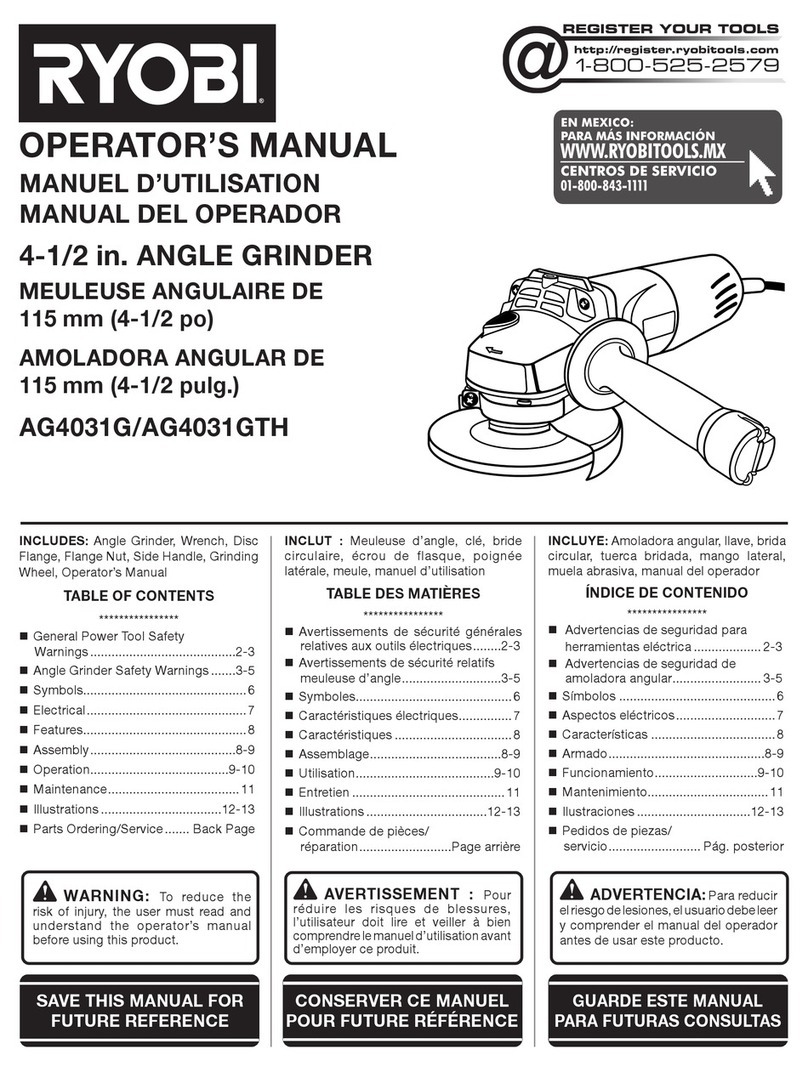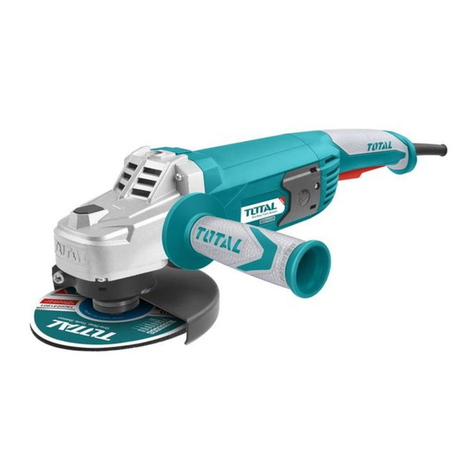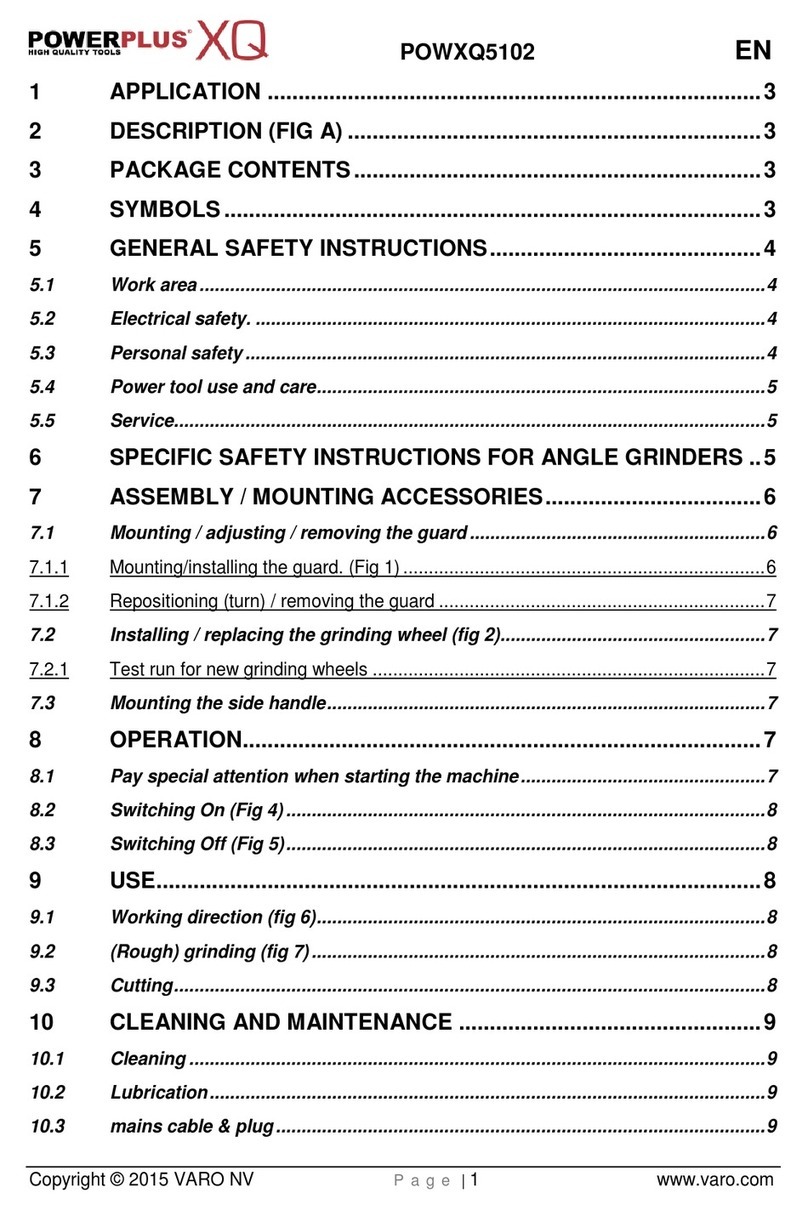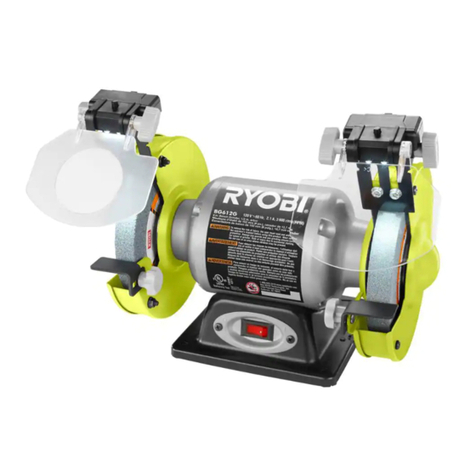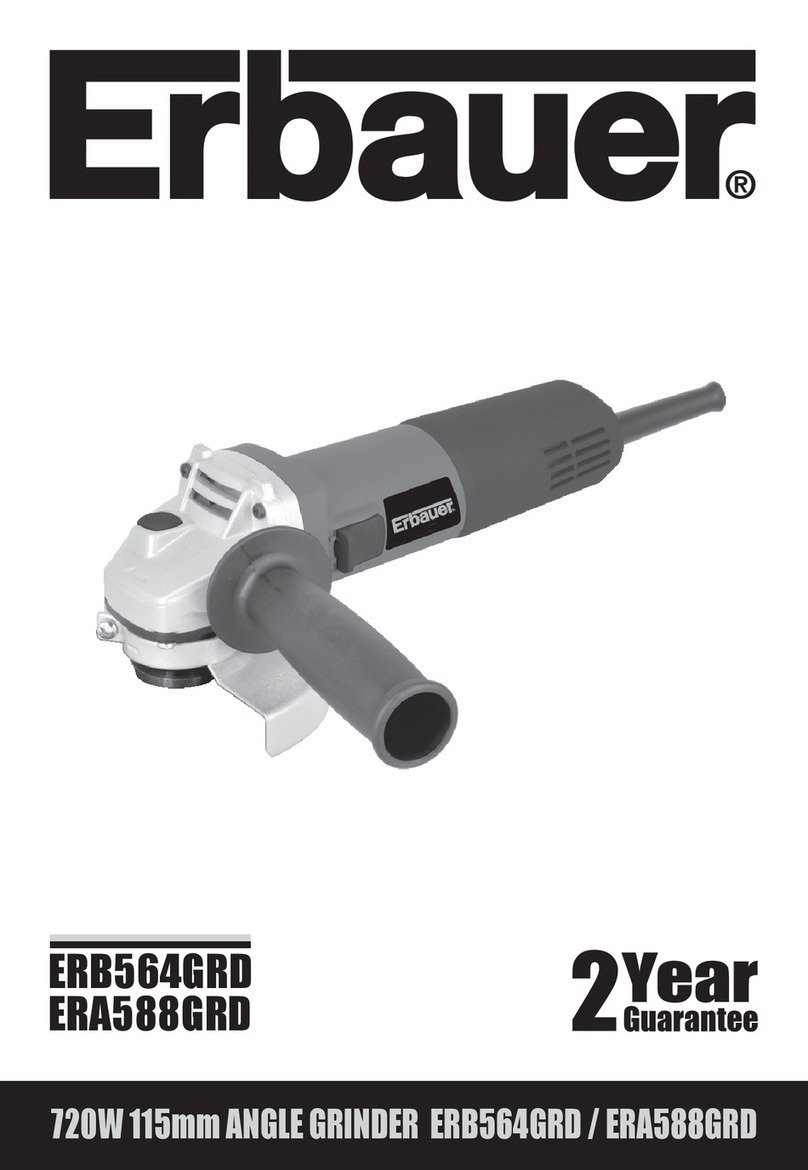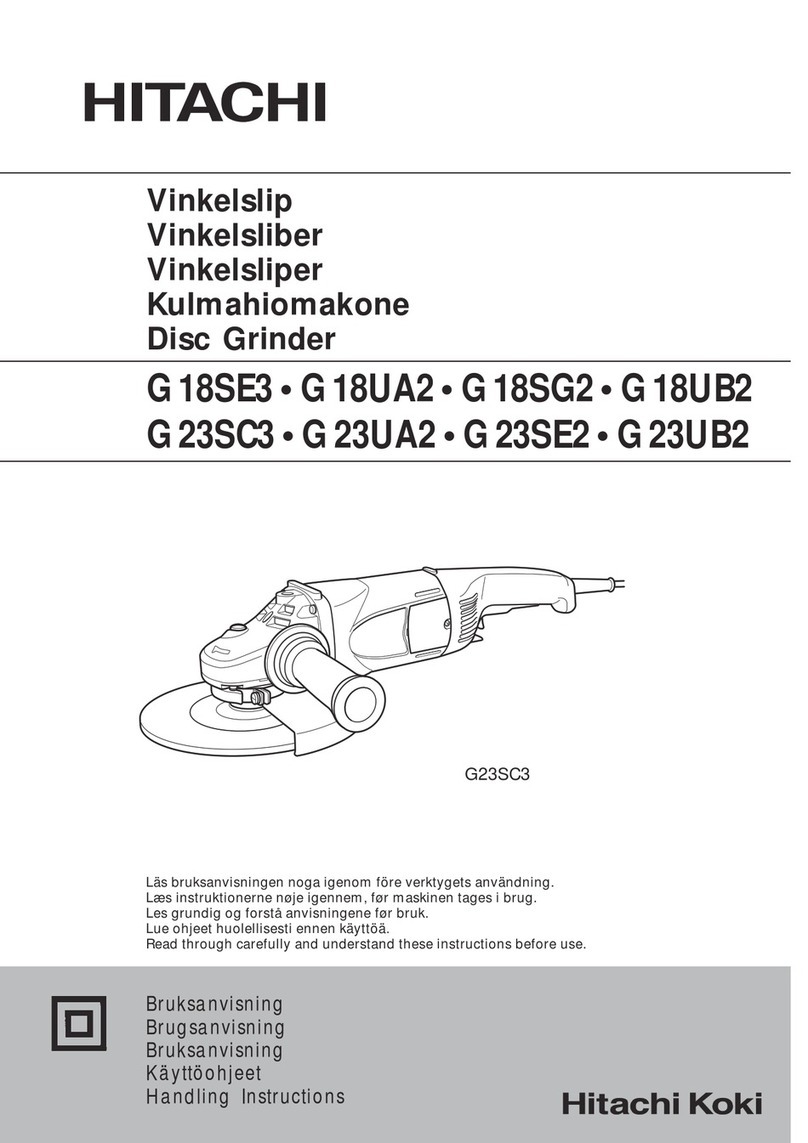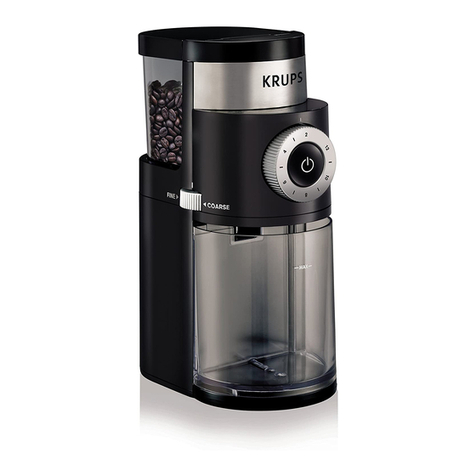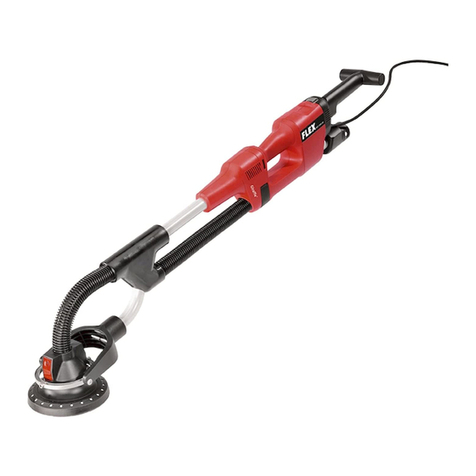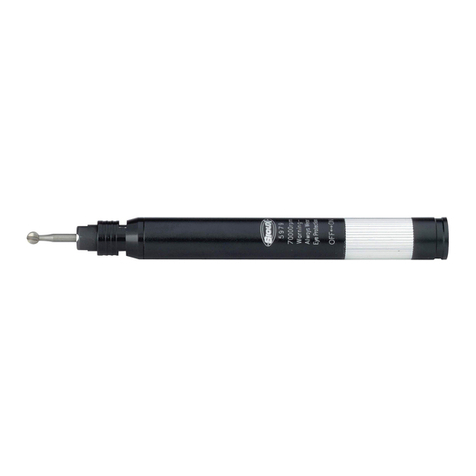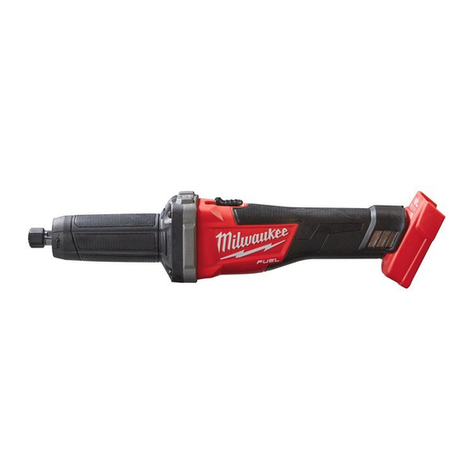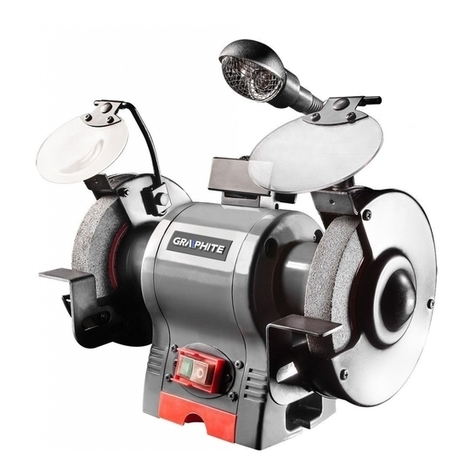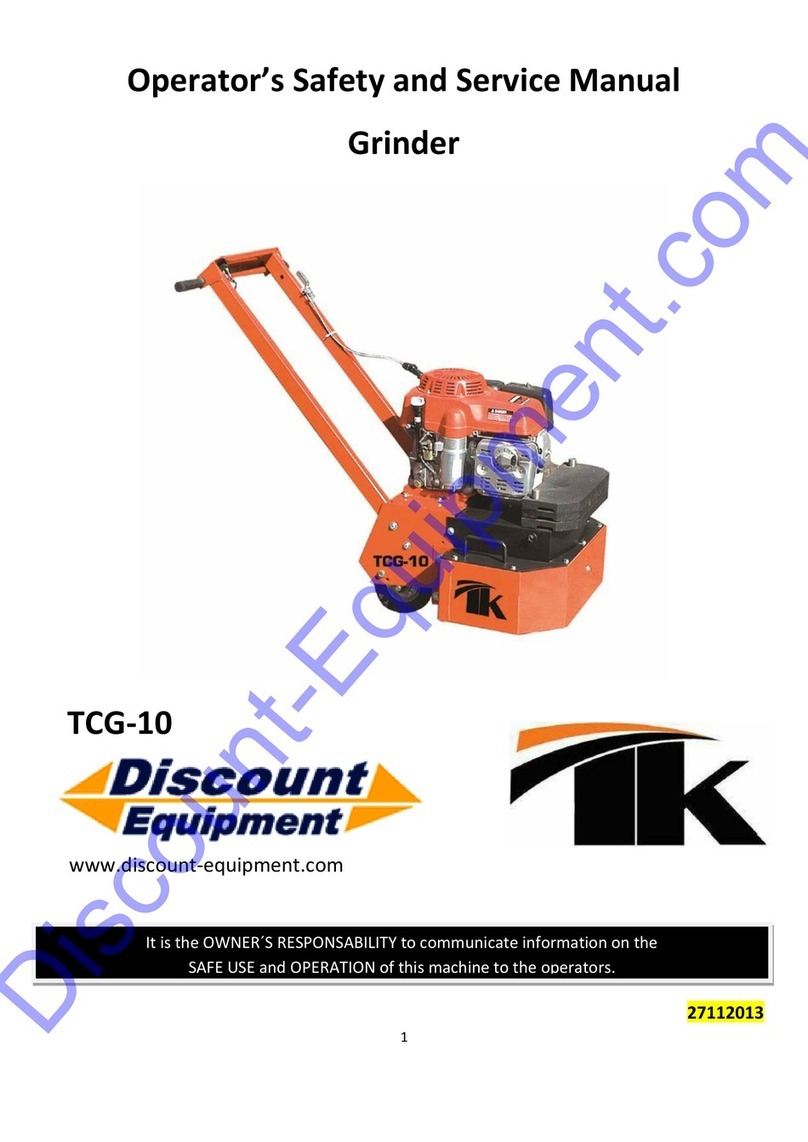Cleco 500 Series User manual

For additional product information visit our website at:
https://dotcotool.com/product-category/cleco-tools/cleco-grinders/cleco-horizontal-grinders-
cleco-grinders/cleco-500b-series-cut-off-wheel-grinders/
Parts Manual
823130
05/10/2011
500 Series
Horizontal Grinders
5 XXX B H X - XX
Tool Series
5 = 500 Series
Speed Options (RPM)
60 = 6,000 120 = 12,000
90 = 9,000
Generation
B = Second
Tool Type
H = Horizontal
Throttle
L= Locking Lever
X = Spade
Wheel Type
14 =
4" Type 1
P= Plug
16 = 6" Type 1

2
Safety Recommendations
Do not use tool to drain residual air from air line, instead use of a self-relieving
valve located near tool is highly recommended.
The wheel guard is designed to prevent serious injury to the operator in the
event of wheel failure and must not be modified in any way. Any wheel guard
that is damaged or bent must be replaced.
NOTE: The grinder must be held so that the opening in the guard is away from
the operator.
Cone and plug wheels less than 3" in diameter and 5" in length are generally
used for internal grinding or operations where the work piece offers protec-
tion. On internal grinding operations where the workpiece offers protection to
the operator wheel guards are not required.
The guard must be securely attached to the grinder with all bolts, nuts, and
lockwashers in place and torqued to 30 - 40 in-lbs.
The speed rating and warning information on the tool should be
maintained or replaced for legibility in the event of damage. Before
mounting a grinding wheel, after all tool repairs, and whenever a grinder is
issued for use, check the free speed of the tool with a tachometer to make
sure actual free speed at 90 psig (6.2 bar) does not exceed rated free speed
stamped on tool. Grinders in use on the job must be checked at least once
every 20 hours of operation, or once a week, whichever is most frequent.
Checking the free speed after the removal of each worn wheel and before
mounting a new wheel is highly recommended.
INSPECT THE GRINDING WHEEL!
Fragments from a grinding wheel that breaks or comes apart while
rotating can cause serious injury or even death. Inspect grinding wheel
. Check the maximum safe RPM marked on wheel or package. Never use
wheels at or below actual tool speed. Cracked, chipped or faulty grinding
wheels are dangerous. Suspect wheels should not be used and should be
disposed of. Look for cracks, chips, water stains, or signs of abuse or
improper storage. Causes of grinding wheel failures have been traced to
such factors as:
• Dropping, bumping, or abuse (careless handling of the
grinder)
• Improper mounting
• Imbalance
• Improper shipment or storage, or age
• Mismatched speed ratings
• Exposure to water, solvents, high humidity, freezing, and
extreme temperatures
Wheels known to have been subjected to any of the conditions above
can burst violently and should be destroyed rather than risk their use
by someone who may not notice that they are damaged.
1
2
3
4
56
0
OVER
CAUTION!
Personal hearing protection is
recommended when operating
or working near this tool.
WARNING!
Impact resistant eye protection
must be worn while operating
or working near this tool.
Read Operating Instructions carefully. Follow
the Safety Recommendations for your safety
and the safety of others.
Hearing protection is recommended in high noise
areas (above 85 dBA). Close proximity of other
tools, reflective surfaces, process noises, and
resonant structures can substantially contribute
to the sound level experienced by the user.
WARNING
!
Repetitive work motions and/or vibration
can cause injury to hands and arms.
Use minimum hand grip force consistent with
proper control and safe operation.
Keep body and hands warm and dry.
Avoid anything that inhibits blood circulation.
Avoid continuous vibration exposure.
Keep wrists straight.
Avoid repeated bending of wrists and hands.
Do not remove this tag until
the operator of this tool has
read these safety precautions.
869974
WARNING TAG
(or 203266 Plug
Wheel Grinder)
Warning Labels Guards
202595 & 202596 4"
202406 & 202407 6"
WARNING!
Impact resistant eye protection
must be worn while operating
or working near this tool.
CAUTION!
Personal hearing protection is
recommended when operating
or working near this tool.
WARNING
!
Wear respirator where
necessary.
CAUTION
!
For your safety and the safety of others, read and understand the safety
recommendations before operating any grinder.
Always wear protective equipment and clothing.
Caution: Faceshields do
not provide unlimited pro-
tection against flying par-
ticles and are not to be
considered as eye protec-
tion. ANSI Z87.1 states
that separate eyewear
shall be used. For additional information on eye protection, refer to Federal
OSHA Regulations, 29 CFR, Section 1910.133, Eye and Face Protection,
and ANSI Z87.1, Occupational and Educational Eye and Face Protection.
This standard is available from the American National Standards Institute,
Inc., 11 West 42nd Street, New York, NY 10036.
Hearing protection is rec-
ommended in high noise
areas (above 85 dBA).
Close proximity of addi-
tional tools, reflective sur-
faces,processnoises,and
resonant structures can
substantially contribute to the sound level experienced by the operator.
Proper hearing conservation measures, including annual audiograms and
training in the use and fit of hearing protection devices may be necessary.
For additional information on hearing protection, refer to Federal OSHA
Regulations, 29 CFR, Section 1910.95, Occupational Noise Exposure, and
American National Standards Institute, ANSI S12.6, Hearing Protectors.
•Gloves and other protective clothing should be worn as
required, unless they create a greater hazard.
•Do not wear loose fitting clothing, or clothing that may
restrict movement, become entangled or in any way
interfere with the safe operation of the grinder.
Grinding or other use of
this tool may produce haz-
ardous fumes and/or dust.
To avoid adverse health
effects utilize adequate
ventilation and/or a respi-
rator. Respirators should
be selected, fitted, used and maintained in accordance with Occupational
Safety and Health Administration and other applicable regulations. Read the
material safety data sheet on any materials involved in the grinding process.
Cleco grinders are designed to operate on 90 psig (6.2 bar) max. air pressure.
If the tool is properly sized and applied, higher air pressure is unnecessary.
Excessive air pressure increases the loads and stresses on the tool parts and
may result in breakage. Installation of a filter-regulator-lubricator in the air
supply line is highly recommended.
Never use the air hose for supporting, lifting, or lowering the tool. Use a safety
line or cable on the tool when working in elevated areas.
Before the tool is connected to air supply, check throttle for proper operation,
i.e., throttle moves freely and returns to closed position. Being careful not
endanger adjacent personnel, clear air hose of accumulated dust
and moisture. Use protective barriers where necessary —hot sparks can
burn. Barriers also help reduce noise levels. Before removing tool from
service or changing accessories, make sure air line is shut off and drained
of air. This will prevent tool from operating if throttle is accidently engaged.

3
Safety Recommendations
CHECK FLANGE
A Type 1 wheel grinder's driving flanges must be relieved,
free of nicks and burrs that might cause stress concentra-
tions on the wheel which can cause cracks. Blotters must
be used and be as large in diameter as the flanges.
Diameters of driving and outer flange must be equal and
measure at least 1/3 dia. of the wheel. If flanges are less
than 1/3 dia. of wheel, do not use grinder or select proper
wheel. Spindle should be checked for damage or abuse.
Spindle end nut must be tightened firmly against outer
flange to insure necessary friction against blotters to drive
wheel. Caution: Overtightening can cause wheel break-
age. Type 1 breakage can also occur if:
•Outer flange is left off
•Outer flange is reversed
•A washer is used in place of either flange
•Outer and driving flange are different diameters
•Blotters are not used
•Wheel is side loaded (Grind on periphery only!)
Threaded hole cone/plug wheel flanges should be flat, at least 1/3 the
diameter of the wheel, and not relieved (relieved flanges can pull the threaded
insert out of the wheel). Always use a blotter as large as the driving flange.
Do not use spacers between the cone/plug wheel and the driving flange. The
grinder spindle must be shorter than the depth of the threads in the cone/plug
wheel.
BEGINNING GRINDING OPERATION
Before using or after mounting a wheel, tool must be run for one minute in a
protected enclosure to check the integrity of the wheel . During this time or
any other time, no one should stand in front or in line of the wheel. When
starting work with a cold wheel, apply it gradually to the workpiece until it
becomes warm. Do not continue to use a grinder if:
•It is not equipped with proper wheel guard
•It starts to vibrate
•You sense changes in tool speed or an unusual increase
in noise that would indicate tool is running at excessive
speed
•You notice excessive end play in spindle
•You hear any unusual sound from grinder
RETURN THE TOOL TO THE TOOL CRIB FOR SERVICE IMMEDIATELY!
Some individuals may
be susceptible to dis-
ordersofthehandsand
arms when performing
tasks consisting of
highly repetitive mo-
tions and/or exposure
to extended vibration.
Cumulativetraumadis-
orders such as carpal
tunnel syndrome and
tendonitis may be caused or aggravated by repetitious, forceful exertions of
the hands and arms. Vibration may contribute to a condition called Raynaud's
Syndrome. These disorders develop gradually over periods of weeks,
months, and years. It is presently unknown to what extent exposure to
vibrations or repetitive motions may contribute to the disorders. Hereditary
factors, vasculatory or circulatory problems, exposure to cold and damp-
ness, diet, smoking and work practices are thought to contribute to the
conditions. Tool operators should be aware of the following warning signs
and symptoms so that a problem can be addressed before it becomes a
debilitating injury. Any user suffering prolonged symptoms of tingling,
numbness, blanching of fingers, clumsiness or weakened grip, nocturnal
pain in the hand, or any other disorder of the shoulders, arms, wrists, or
fingers is advised to consult a physician. If it is determined that the symptoms
are job related or aggravated by movements and postures dictated by the job
design, it may be necessary for the employer to take steps to prevent further
occurrences. These steps might include, but are not limited to, repositioning
the workpiece or redesigning the workstation, reassigning workers to other
jobs, rotating jobs, changing work pace, and/or changing the type of tool used
so as to minimize stress on the operator. Some tasks may require more than
one type of tool to obtain the optimum operator/tool/task relationship.
The proper selection of the correct type of grinder is an important ergonomic
consideration. Each application should be carefully considered and the tool
chosen that will minimize the stresses on the operator that can lead to the
onset of cumulative trauma disorders. Some tasks require more than one
type of tool to obtain the optimum operator/tool/task relationship. Cleco
offers a complete selection of tools including vertical, straight, angle, and
extended grinders that make possible the correct ergonomic match of the
operator, tool, and task.
The following suggestions will help reduce or moderate the effects of
repetitive work motions and/or extended vibration exposure:
•Use a minimum hand grip force consistent with proper
control and safe operation
•Keep body and hands warm and dry (cold weather is
reported to be a major factor contributing to Raynaud's
Syndrome)
•Avoid anything that inhibits blood circulation
—Smoking Tobacco (another contributing factor)
—Cold Temperatures
—Certain Drugs
•Tasks should be performed in such a manner that the
wrists are maintained in a neutral position, which is not
flexed, hyperextended, or turned side to side
•Stressful postures should be avoided —select a tool
appropriate for the job and work location
•Avoid highly repetitive movements of hands and wrists,
and continuous vibration exposure (after each period of
operation, exercise to increase blood circulation)
•Use quality abrasive wheels (the primary source of vi-
bration when using a grinder is a wheel that is out of
balance, out of round, untrue, or possibly any combina-
tion of all three)
•Keep tool well maintained and replace worn parts (a
preventive maintanance program with scheduled inspec-
tions is highly recommended)
1/3 Dia.
of wheel
Relieved Flange
TYPE 1
Repetitive work motions and/or vibration
may cause injury to hands and arms.
Use minimum hand grip force consistent
with proper control and safe operation.
Keep body and hands warm and dry.
Avoid anything that inhibits blood circulation.
Avoid continuous vibration exposure.
Keep wrists straight.
WARNING
!
Avoid repeated bending of wrists and hands.
Extension Neutral Flexion Radial Deviation Neutral Ulnar Deviation
Avoid Avoid Avoid
OK Avoid OK
GRINDING
FACE
!WARNING
Extreme caution should
be exercised not to use
excessive side pressure.
Excessive side pressure
can break the wheel and
result in severe injury.
Guard not
shown for
clarity.
TYPE 1
WHEEL
Blotter
Relieved flanges
minimum 1/3 dia.
of wheel dia.
Do not grind with
side of Type 1 wheel.

4
Safety Recommendations
Work gloves with vibration reducing liners and wrist supports are available
from some manufacturers of industrial work gloves. Tool wraps and grips are
also available from a number of different manufacturers. These gloves,
wraps, and wrist supports are designed to reduce and moderate the effects
of extended vibration exposure and repetitive wrist trauma. Since they vary
widely in design, material, thickness, vibration reduction, and wrist support
qualities, it is recommended that the glove, tool wrap, or wrist support
manufacturer be consulted for items designed for your specific application.
WARNING! Proper fit of gloves is important. Improperly fitted gloves
may restrict blood flow to the fingers and can substantially reduce grip
strength.
USE QUALITY ABRASIVE WHEELS
The primary source of vibration when using a portable grinder is an abrasive
wheel that is out of balance, out of round, untrue, or possibly any combination
of all three.
The use of quality abrasive wheels which are well balanced, round, and true
is highly recommended as they have been found to significantly reduce
vibration. Some abrasive wheels lose their balance, roundness, and truth as
they wear from use. Because of the abusive nature of the vibration caused
by out of balance, out of round, and untrue condition of some abrasive
wheels, it is felt that these wheels are more suseptible to failure. Excessive
vibration may signal eminent wheel failure. Out of balance abrasive wheels
are dangerous. Flat spotting of the abrasive wheel, caused by grinding the
wheel to a stop after the power has been shut off can result in changes to the
balance and shape of the wheel. Be sure the grinding wheel has stopped
before setting the tool down. Set the tool in a tool rest or tool holder when not
in use.
WIRE BRUSHES
If a grinder is used for wire brushing applications the same problems of
balance, roundness, and truth as experienced with abrasive wheels prevail.
Use quality wire brushes.
USE A PREVENTIVE MAINTENANCE PROGRAM
Tool abuse or poor maintenance procedures can amplify and contribute to
the vibration produced by the abrasive wheel. A preventive maintenance
program featuring scheduled periodic inspections and proper maintenance
is the best way to assure safety in your portable grinding operations. A well
managed program can, for example, detect such things as speed variations
due to wear, flanges or spindles that have been damaged from abuse, or bad
bearings damaged by foreign matter or lack of lubrication. Problems such as
these can affect the wheel trueness when the grinder is running and
contribute to the vibration. Rotor blades that are worn or chipped can lock up
the motor and damage motor components. Rotor blades should be checked
periodically and replaced if they measure less than 5/16" (8 mm) at either
end.
Proper repair procedures and the use of original Cleco service parts and
bearings rather than substitutes will return the tool to factory specifications
of precision and balance, and minimize vibration.
PROPER LUBRICATION
An automatic in-line filter-regulator-lubricator is recommended as it in-
creases tool life and keeps the tool in sustained operation. The in-line
lubricator should be regularly checked and filled with a good grade of 10W
machine oil. Proper adjustment of in-line lubricator is performed by placing
a sheet of paper next to exhaust ports and holding throttle open approxi-
mately 30 seconds. Lubricator is properly set when a light stain of oil collects
on paper. Excessive amounts of oil should be avoided.
STORAGE
In the event it becomes necessary to store tool for an extended period of time
(overnight, weekend, etc.), it should receive a generous amount of lubrication
at that time and run for several seconds to distribute oil before disconnecting
from air supply. This will reduce corrosion and displace water that may be
trapped in tool. Water trapped in the tool could cause the governor to freeze
and malfunction if tool is exposed to freezing temperatures.
The governor should be checked periodically to be sure the governor
mechanism is clean, in good operating condition, and functioning properly.
This information is a compilation of general safety practices obtained from
various sources available at the date of production. However, our company
does not represent that every acceptable safety practice is offered herein, or
that abnormal or unusual circumstances may not warrant or require addi-
tional procedures. Your work may require additional specific safety proce-
dures. Follow these procedures as required by your company. For more
information, see the latest edition of ANSI B186.1, Safety Code for Portable
Air Tools,and ANSI B7.1, Safety Requirements for the Use, Care, and
Protection of Abrasive Wheels, available from the American National
Standards Institute, Inc., 11 West 42nd Street, New York, NY 10036.
Must be replaced if
5/16" (8mm) or less
at either end.

5
READ SAFETY RECOMMENDATIONS BEFORE
CONNECTING TOOL.
The 500B Series Grinders are designed to operate on 90psig (6.2 bar)
maximum air pressure, using a 1/2" hose up to 8' in length. If additional
length is required, the next larger hose size may be connected to the 8'
whip hose.
LUBRICATION
An automatic in-line filter-lubricator is recommended as it increases tool
life and keeps the tool in sustained operation. The in-line lubricator
should be regularly checked and filled with a good grade of 10W
machine oil. Proper adjustment of the in-line lubricator is performed by
placing a sheet of paper next to the exhaust ports and holding the
throttle open approximately 30 seconds. The lubricator is properly set
when a light stain of oil collects on the paper. Excessive amounts of oil
should be avoided.
STORAGE
In the event that it becomes necessary to store the tool for an extended
period of time (overnight, weekend, etc.), it should receive a generous
amount of lubrication at that time and again when returned to service.
The tool should be stored in a clean and dry environment.
DISASSEMBLY
Slip the rubber grip, No. 867370, forward to expose the flats on the
housing, No. 867378. Clamp the housing in a soft-jawed vise with the
handle up and unscrew the handle assembly. The complete motor unit
may now be slipped out the rear of the housing. Remove the housing
from the vise and unscrew the arbor nut. This will allow the arbor washer,
collar retainer, arbor collar, and arbor key to be removed from the arbor.
This completes disassembly of the tool into three major assemblies.
See the following paragraphs for complete disassembly instructions.
HOUSING: Clamp the housing in the vise and unscrew (left hand
threads) the arbor bearing retainer, No. 864510. This will allow the arbor
with attached components to be removed from the front of the housing.
Remove the coupling, No. 867371, from the rear of the arbor. If
replacement of the arbor bearings is necessary, they may be pressed
off the arbor shaft.
MOTOR: Clamp the rotor lock nut, No. 842627, in the vise with the
governor assembly up. Push the governor adjusting ring, No. 867214,
down and slip the lock pin, No. 867187, out of the assembly. This will
allow the adjusting ring and governor spring, No. 867186 to be removed.
Unscrew (left hand threads) and remove the governor spider and pin
retainer, No. 864532, from the motor unit. Push the governor weight
pins, No. 867184, out of the spider to remove the governor weights.
Remove the motor unit from the vise and clamp on the cylinder with the
threaded end of the rotor up. Drive the rotor, No. 867367, out of the rear
rotor bearing, No. 864522, being careful not to damage the threads.
Remove the cylinder, No. 867377, and three rotor blades, No. 864562,
from the rotor. Clamp the body of the rotor in the vise with the splined
end up and unscrew the rotor lock nut. This will allow the rotor to be
driven out of the front rotor bearing, No. 844363.
HANDLE: Unscrewing the inlet bushing, No. 847679, will allow the
bushing and oiler assembly to come out as a unit for cleaning and
inspection of the inlet screen, No. 864533. Should the screen need
replacing, the oiler body, No. 867192, may be pressed out of the inlet
bushing using a 1/2" rod.
The throttle valve assembly on the spade and lever handles may be
removed by unscrewing the throttle valve cap.
OPERATING INSRUCTIONS REASSEMBLY
The tool is reassembled in the reverse order of disassembly. All parts
should be thoroughly cleaned and inspected for wear before reassem-
bly. Particular attention should be paid to the governor assembly,
replacing any of its' parts that show wear or damage. It is recommended
that new rotor blades be installed at each repair cycle. If not replaced,
the used ones must measure a minimum of 5/16" (8mm) at both
ends.Failure of these parts could cause damage to more expensive
components.
Ball bearings should be replaced if they are rough or show excessive
looseness. Pack bearings with a generous amount of NLGI 2-EP grease
before reassembly. All bearings should be installed with the shielded
side to the rear of the tool.
HOUSING: Install the front arbor bearing, No. 864524, so that the
shielded side of the bearing face toward the rear of the housing. If the
felt retainer ring, No. 617726, is removed, a new one should be used
during reassembly. When installing the arbor bearing retainer, No.
864510, apply grade "271" Loctite (red) to the threads (left hand) before
screwing it into the housing. The retainer should then be torqued to 75-
85 ft. lbs.
MOTOR: During reassembly of the motor, the rotor must be positioned
by the rotor collar, No. 864515, so that when assembled, the rotor will
have .0015" clearance between it and the front bearing plate. To set the
rotor collar, asemble the front rotor bearing (shield toward rear) into the
front bearing plate and measure the depth of the inner race from the face
of the bearing plate. Select, or fit by sanding, a rotor collar .0015" larger
than this dimension. Clamp the rotor body in the vise (spline end up) and
slip the rotor collar, chamfered side first, on the rotor shaft and drive the
bearing plate and bearing (drive on the inner race) down on the rotor
collar. Screw the rotor lock nut, No. 842627, down and torque to 40-60
ft. lbs. When installing the rear rotor bearing, No. 864522, the shielded
side must be to the rear of the tool.
Caution: The governor pin retainer, No. 864532, must be installed
under the governor to prevent the pins from coming out. The governor
(left hand threads) should be torqued to 15-20 ft. lbs. during reassembly.
HANDLE: The handle is assembled in the reverse order of disassem-
bly. Inspect all seals, replacing those that have deteriorated in any
way.The governor valve seat No. 867170 should be tightened to 25 ft.
lbs. when installing into handle. The inlet bushing No. 847679 should be
tightened to 70-80 ft. lbs. When assembling the handle to the motor
housing, it must be torqued to 130-150 ft. lbs.
After reassembly of the complete tool, the RPM must be checked.
Caution: Be sure to check the tool for proper speed with a
dependable tachometer before returning it to service.
To adjust the RPM, rotate the governor adjusting ring, No. 867214, in
a clockwise direction to increase the RPM and counterclockwise
direction to lower the RPM.
SERVICE INSRUCTIONS
Must be replaced if
5/16" (8mm) or less
at either end.

6

7
PART NO.
203215
203495
617726
812166
842426
842627
843521
843526
844363
847528
847946
864510
864515
864522
864524
864532
864562
867183
867184
867185
867186
867187
867188
867189
867214
867358
867367
867369
867370
867371
867372
867377
867378
867386
867483
867484
882885
QTY.
1
1
1
2
1
1
1
4
1
1
1
1
1
1
1
1
3
1
2
1
1
1
2
2
1
2
1
1
1
1
1
1
1
1
1
1
1
PARTS LIST—HOUSING & MOTOR UNIT
NAME OF PART
HOUSING (BSLP ONLY) (INCL. 843521, 843526)
INSTRUCTION PLATE (BSLP)
FELT RETAINER RING
CYLINDER PIN
FELT RING
ROTOR LOCK NUT
INSTRUCTION PLATE (BX, BSL)
DRIVE SCREW
FRONT ROTOR BEARING
REAR SPINDLE BEARING
COLLAR RETAINER (5/8" SPINDLE)
SPINDLE BEARING RETAINER
ROTOR COLLAR
REAR ROTOR BEARING
FRONT ARBOR BEARING
PIN RETAINER
ROTOR BLADE
GOVERNOR SPIDER
GOVERNOR WEIGHT PIN
GOVERNOR VALVE
GOVERNOR SPRING
LOCK PIN
GOVERNOR WEIGHT (12,000 RPM)
GOVERNOR WEIGHT (6,000 RPM)
GOVERNOR ADJUSTING RING
GOVERNOR WEIGHT (9,000RPM)
ROTOR
REAR BEARING PLATE
RUBBER GRIP
COUPLING
EXHAUST DEFLECTOR
CYLINDER (INCL. 812166)
HOUSING (BX,BSL) (INCL. 843521, 843526)
141B00 "O"-RING 2-5/16" X 2-1/2"
RETAINER RING
KEY
FRONT BEARING PLATE

8

9
202337
622881
812977
832211
832595
834619
843590
844155
844303
844310
844653
845090
847679
847710
864195
864375
864387
864530
864531
864533
864581
864582
865341
867170
867192
867215
867374
867379
867468
869687
869688
THROTTLE VALVE
"O"-RING 7/8" X 1-1/8"
TRIGGER STOP PIN
THROTTLE STEM BUSHING
THROTTLE VALVE SPRING
"O"-RING 13/16" X 5/`6"
OILER VALVE
THROTTLE VALVE CAP
"O"-RING 3/16" X 5/16"
"O"-RING 1/2" X 11/16"
PAWL PIN
LEVER PIN
INLET BUSHING
"O"-RING
TRIGGER PIN
THROTTLE VALVE SEAL
OIL PLUG
THROTTLE VALVE BUSHING
THROTTLE VALVE CAP
INLET SCREEN
THROTTLE VALVE STEM
TRIGGER
NYLON LOCKING RING
GOVERNOR VALVE BUSHING
OILER BODY
LOCK-OFF LEVER
HANDLE (INCL. 864530, 865341)
HANDLE (INCL. 832211, 865341)
THROTTLE VALVE SPRING
PAWL SPRING
LOCK-OFF PAWL
NAME OF PART
PART NO. SPADE
QTY.
1
1
1
1
2
1
1
1
1
1
1
1
1
1
1
1
1
1
1
1
LOCK-OFFLEVER
QTY.
1
1
1
2
1
1
1
1
1
1
1
1
1
1
1
1
1
1
1
1
1
1
THE COMPLETE HANDLE CAN BE PURCHASED AS A SUBASSEMBLY.
SPADE — CODE NO. 861437
LOCK-OFF LEVER — CODE NO. 861839
PARTS LIST—HANDLE SUBASSEMBLIES

10
DRIVING FLANGE
Thread Part No.
5/8"-11 869699
STUB SPINDLE
Thread Part No.
5/8"-11 869703
202574
DRIVING FLANGE
Thread Part No.
5/8"-11 869708
FULL LENGTH SPINDLE
Thread Part No.
5/8"-11 867382
SPINDLE END NUT
Thread Part No.
5/8"-11 843846
OUTER FLANGE
RPM Spindle Flange Wheel Part No.
Size Dia. Size
12,000
&
9,000 5/8" X 11 1-17/32" (39mm) 4" (100mm) 864561
6,000 5/8" X 11 2" (50mm) 6" (150mm) 847047
NOTE: OUTER FLANGE AND
DRIVING FLANGE MUST BE
THE SAME DIAMETER.
NOT SHOWN
DRIVING FLANGE WRENCH
889300 - (1-11/32" X 1 - 13/16")
FULL LENGTH SPINDLE
Radial Wheel
CONE GRINDER
(Stub Spindle)
FULL LENGTH SPINDLE
WITH CONE/PLUG
WHEEL DRIVING
FLANGE
DRIVING FLANGE
RPM Spindle Flange Wheel Part No.
Size Dia. Size
12,000
&
9,000 5/8" X 11 1-17/32" (39mm) 4" (100mm) 864555
6,000 5/8" X 11 2" (50mm) 6" (150mm) 864525
GUARD
RPM Size Part No. Max. Type 1
Straight Wheel Capacity
12,000 4" (100mm) 881608 4" (100mm) x 1" (25mm)
9,000 4" (100mm) 881608 4" (100mm) x 1" (25mm)
6,000 6" (150mm) 865993 6" (150mm) x 1" (25mm)

11
202574
843846
847047
864525
864555
864561
865993
867382
869699
869703
869708
881608
PARTS LIST —500B EQUIPMENT
SET SCREW
5/8"- 11 SPINDLE END NUT
2" OD (50mm) OUTER FLANGE
2" OD (50mm) DRIVING FLANGE
1-17/32" OD (39mm) DRIVING FLANGE
1-17/32" OD (39mm) OUTER FLANGE
6" (150mm) WHEEL GUARD (6,000RPM)
5/8"- 11 SPINDLE
5/8" X 11 CONE/PLUG WHEEL DRIVING FLANGE
5/8" X 11 STUB SPINDLE
5/8" - 11 STUB SPINDLE DRIVING FLANGE
4" (100mm) WHEEL GUARD (9,000 & 12,000RPM)
PART NO. NAME OF PART QTY.
†
†INCLUDES 202574
1
1
1
1
1
1
1
1
1
1
1
1

Sales & Service Centers
Note: All locations may not service all products. Please contact the nearest Sales & Service Center for
the appropriate facility to handle your service requirements.
Dallas, TX Detroit, MI Houston, TX Lexington, SC
Apex Tool Group Apex Tool Group Apex Tool Group Apex Tool Group
Sales & Service Center Sales & Service Center Sales & Service Center 670 Industrial Drive
1470 Post & Paddock 2630 Superior Court 6550 West Sam Houston Lexington, SC 29072
Grand Prairie, TX 75050 Auburn Hills, MI 48326 Parkway North, Suite 200 Tel: 800-845-5629
Tel: 972-641-9563 Tel: 248-391-3700 Houston, TX 77041 Tel: 803-951-7544
Fax: 972-641-9674 Fax: 248-391-7824 Tel: 713-849-2364 Fax: 803-358-7681
Fax: 713-849-2047
Los Angeles, CA Seattle, WA York, PA Canada
Apex Tool Group Apex Tool Group Apex Tool Group Apex Tool Group
Sales & Service Center Sales & Service Center Sales & Service Center Sales & Service Center
15503 Blackburn Avenue 2865 152nd Avenue N.E. 3990 East Market Street 5925 McLaughlin Road
Norwalk, CA 90650 Redmond, WA 98052 York, PA 17402 Mississauga, Ont. L5R 1B8
Tel: 562-623-4457 Tel: 425-497-0476 Tel: 717-755-2933 Canada
Fax: 562-802-1718 Fax: 425-497-0496 Fax: 717-757-5063 Tel: 905-501-4785
Fax: 905-501-4786
Germany England France China
Cooper Power Tools Cooper Power Tools Cooper Power Tools SAS Cooper (China) Co., Ltd.
GmbH & Co. OHG GmbH & Co. OHG a company of a company of
a company of a company of Apex Tool Group, LLC Apex Tool Group, LLC
Apex Tool Group, LLC Apex Tool Group, LLC 25 rue Maurice Chevalier 955 Sheng Li Road,
Industriestraße 1 C/O Spline Gauges 77330 Ozoir-La-Ferrière Heqing Pudong, Shanghai
73463 Westhausen Piccadilly, Tamworth France China 201201
Germany Staffordshire B78 2ER Tel: +33 1 6443 2200 Tel: +86-21-28994176
Tel: +49 (0) 73 63 81 0 United Kingdom Fax: +33 1 6443 1717 Fax: +86-21-51118446
Fax: +49 (0) 73 63 81 222 Tel: +44 1827 8741 28
Fax: +44 1827 8741 28
Mexico Brazil Hungary
Cooper Tools Cooper Tools Industrial Ltda. Cooper Tools Hungaria Kft.
de México S.A. de C.V. a company of a company of
a company of Apex Tool Group, LLC Apex Tool Group, LLC
Apex Tool Group, LLC Av. Liberdade, 4055 Berkenyefa sor 7
Vialidad El Pueblito #103 Zona Industrial - Iporanga Pf: 640
Parque Industrial Querétaro 18087-170 Sorocaba 9027 Györ
Querétaro, QRO 76220 SP Brazil Hungary
Mexico Tel: +55 15 2383929 Tel: +36 96 66 1383
Tel: +52 (442) 211-3800 Fax: +55 15 2383260 Fax: +36 96 66 1135
Fax: +52 (442) 103-0443
823130/Printed in USA 05/2011/Copyright © Apex Tool Group, LLC
Apex Tool Group, LLC
1000 Lufkin Road
Apex, NC 27539
Phone: 919-387-0099
Fax: 919-387-2614
www.apextoolgroup.com
Table of contents
Other Cleco Grinder manuals
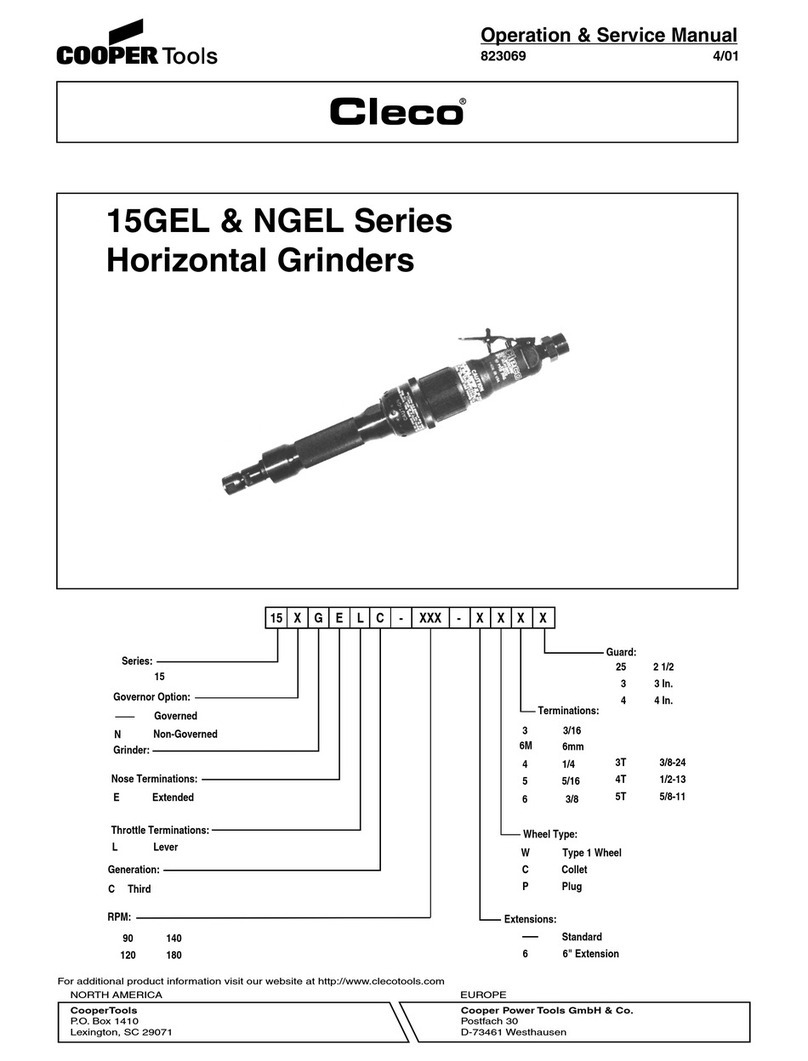
Cleco
Cleco 15GEL Series Installation and operating instructions
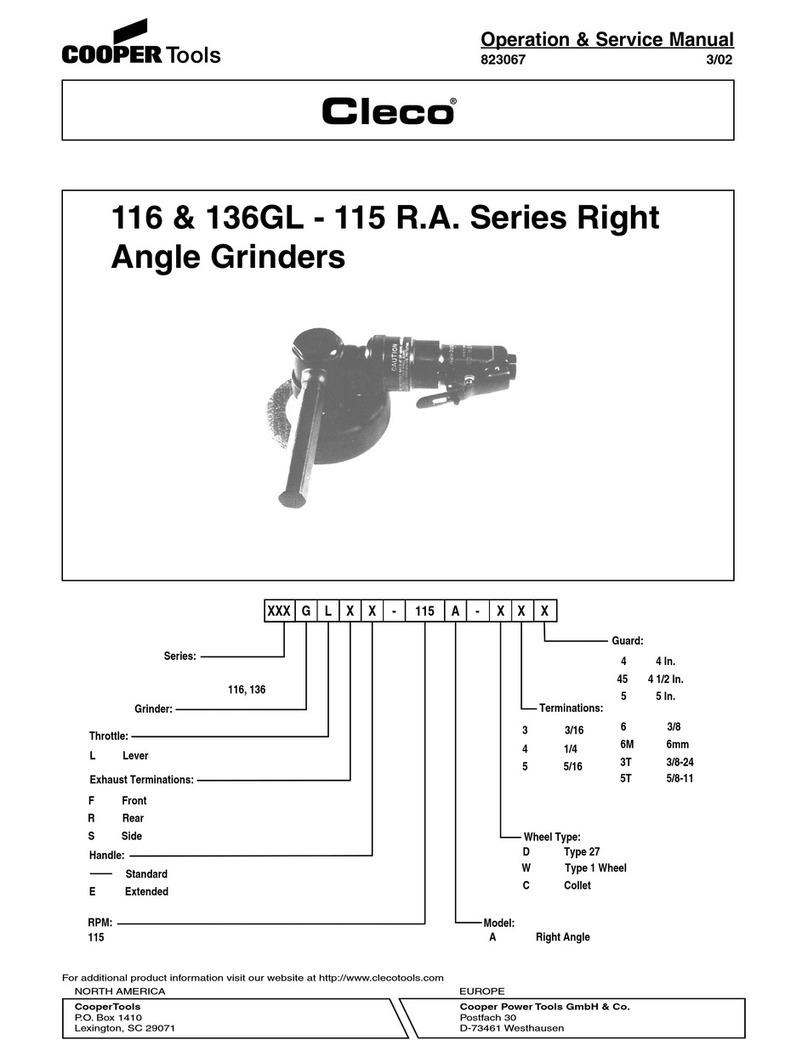
Cleco
Cleco 116 Installation and operating instructions
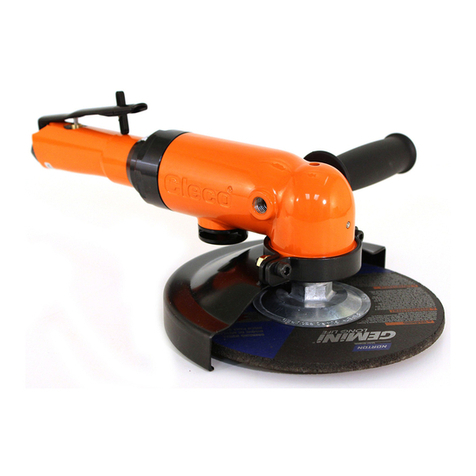
Cleco
Cleco 1660AGL Series User manual

Cleco
Cleco 116GLB-135A Installation and operating instructions

Cleco
Cleco 220 Series User manual
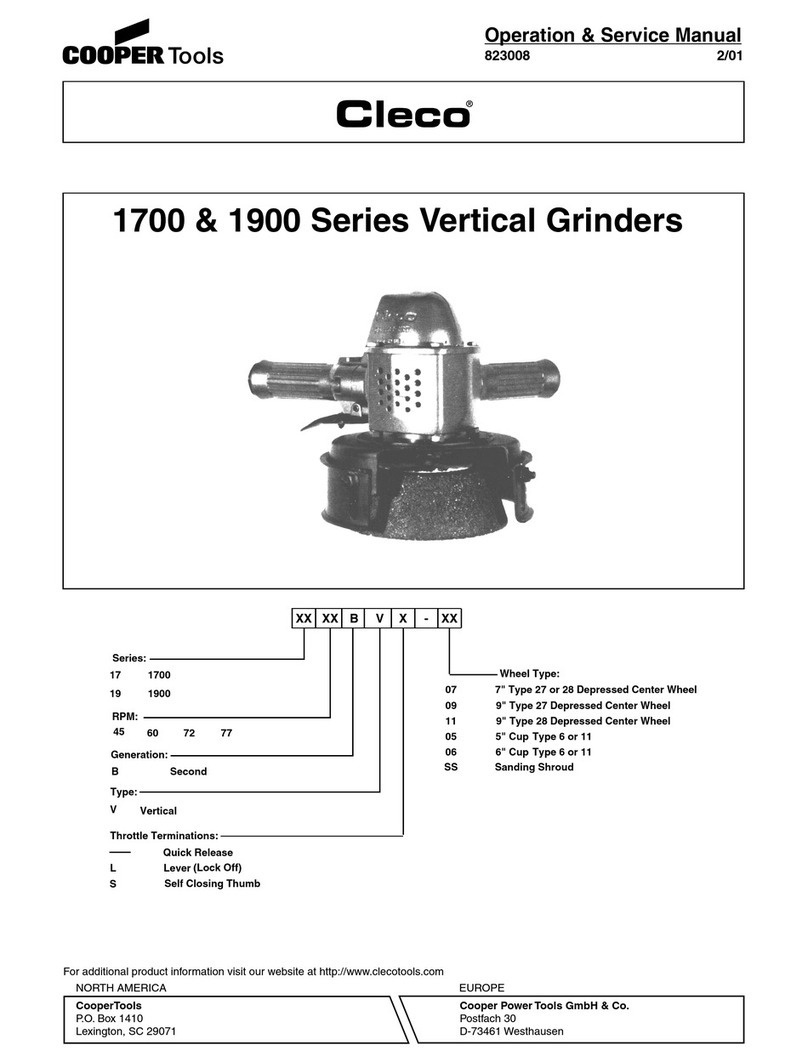
Cleco
Cleco 1700 Series Installation and operating instructions
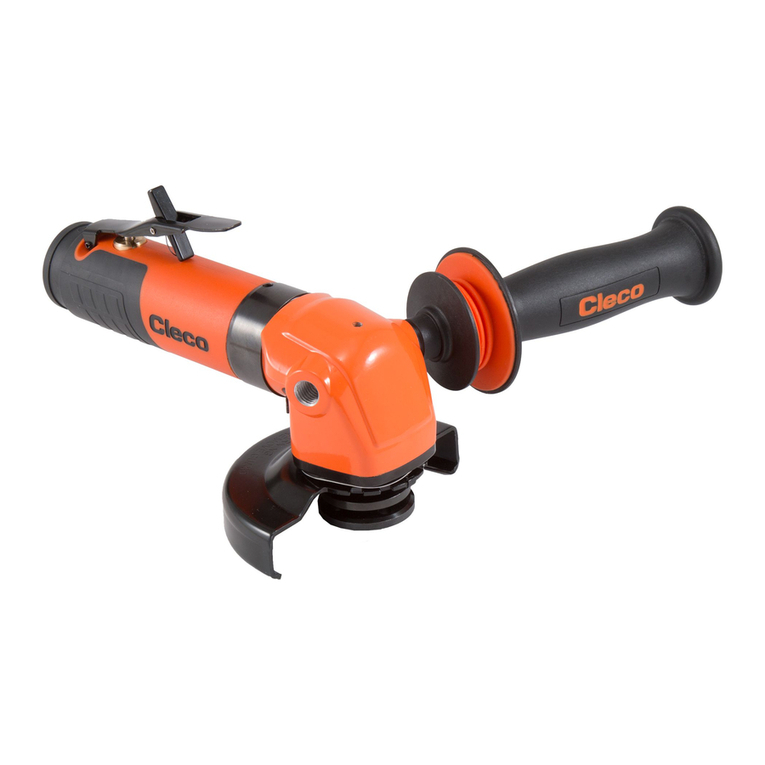
Cleco
Cleco C31 Series User manual
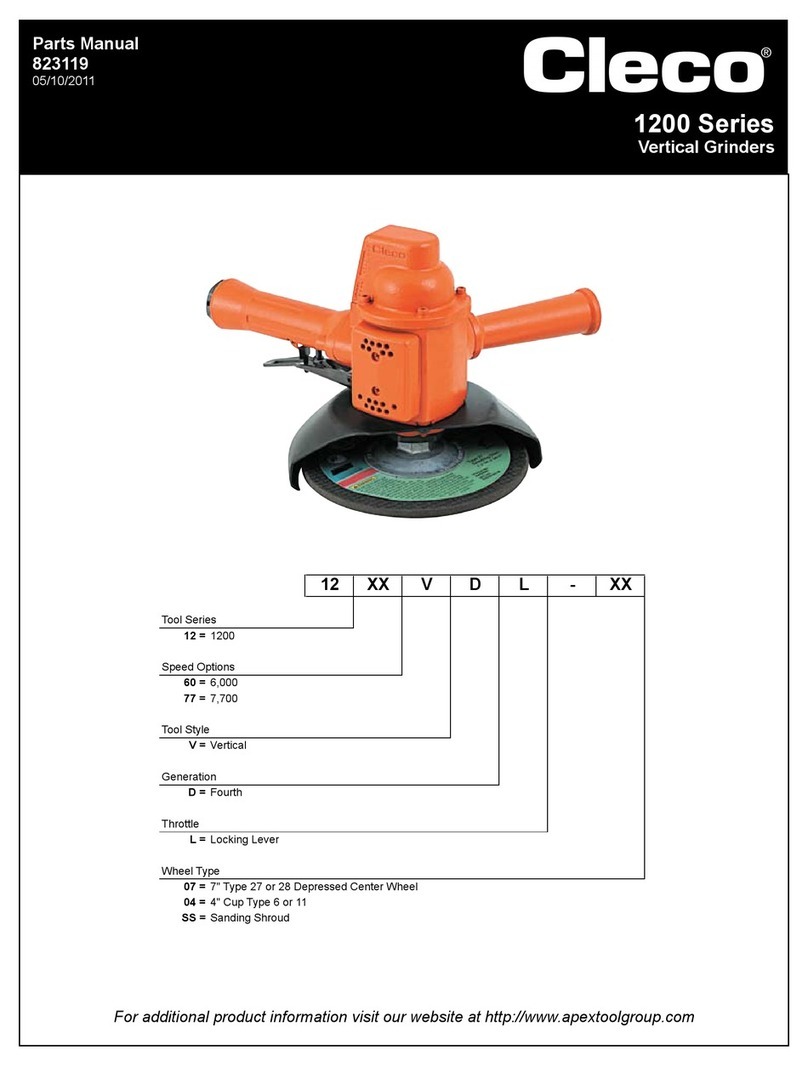
Cleco
Cleco 1200 Series Service manual
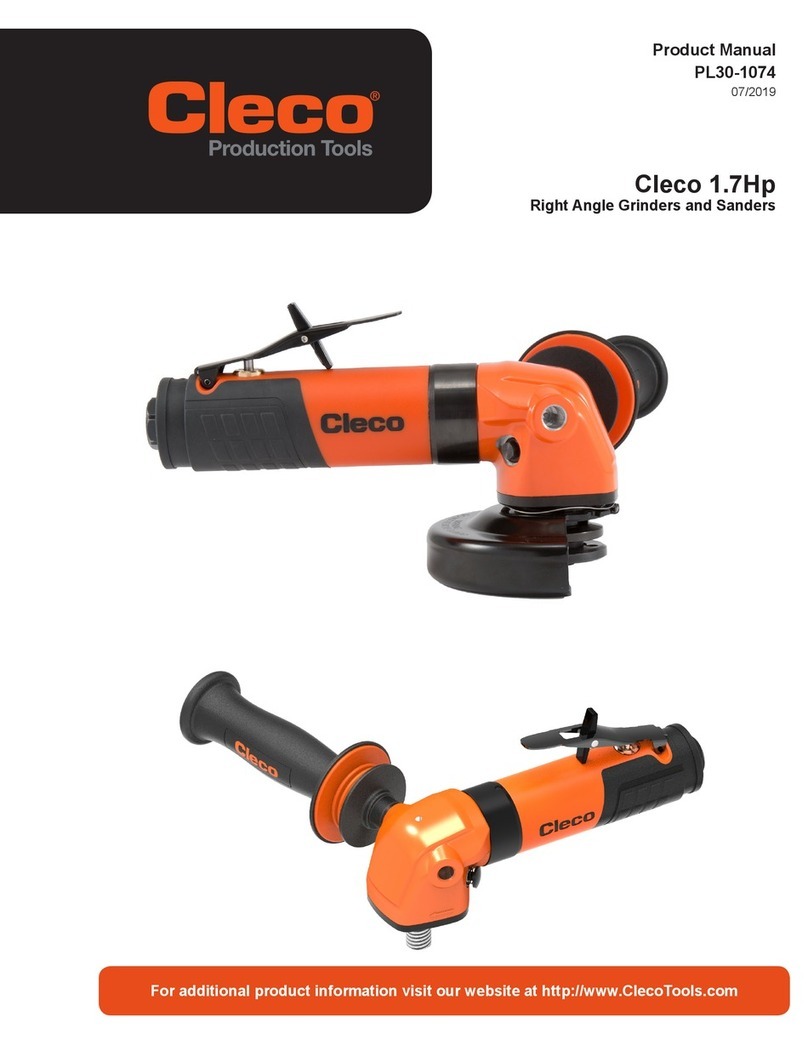
Cleco
Cleco C3120A45-58OH User manual


